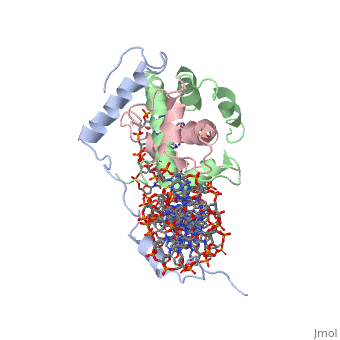NF-Y Transcription Factor
From Proteopedia
OverviewA transcription factor (TF) is a protein that binds to specific DNA sequences and can either repress or activate the transcription of a gene. TFs have a diverse family of proteins and normally exist in a multisubunit complex. NF-Y is a transcription factor involved in histone post-translational modifications (PTMs) [1]. In plants, the NF-Y transcription factors regulate and respond to many physiological responses. NF-Y subunits are closely related to core histones. A histone is a conserved protein that wraps 146 nucleotides of DNA into the basic unit of chromatin, the nucleosome [2]. Histone-fold Domains (HFDs) are required for the tertiary structure of histones and non-sequence specific contacts with DNA[2]. Protein StructureThe NF-Y transcription factor consists of , , and subunits. NF-YA subunit contains two α-helices, NF-YB subunit contains four α-helices and two β-sheets, and NF-YC subunit contains three α-helices and two β-sheets. The NF-YB and NF-YC subunits each contain a histone fold motif and form a NF-YB/NF-YC histone folding domain (HFD) dimer[3]. The composition of mostly α-helices gives the protein flexibility. One of the two α helices of the NF-YA subunit, the N terminal , interacts with NF-YB/NF-YC heterodimer resulting in a heterotrimer.
Protein FunctionThe post-translational modifications (PTMs) that NF-Y transcription factor is associated with aid in identifying regions of DNA that are destined to be transcribed. NF-Y is responsible for recruiting enzymes responsible for transcription (like RNA Polymerase II), and enzymes involved in acetylations on active promoters, suggesting that NF-Y is involved in switch-modifications [2]. Furthermore, NF-Y is a sequence-specific TF. It is possible that NF-Y and other sequence-specific TFs determine histone modifications on promoters[1]. NF-Y is regulated by redox mechanisms[4]. The regulated subunit (NF-YB) has three conserved cysteines in its A2 helix: , , and ; which sense the cellular redox potential and allow heterodimerization under reduced conditions. In oxidized conditions, NF-YB forms heterodimers in the cytoplasm which hinders CCAAT-binding and transcriptional activation[4].
DNA InteractionNF-Y interacts with DNA in several ways; one particular way is by using the C terminal of the NF-YA subunit inserts deep into the minor groove of DNA. NF-YA A2 helix binds to the box and causes the minor groove to widen at the CCAAT box[1]. residues interacting with the CCAAT box prevent G bases due to steric reasons, and these residues perform specific interactions that link the NF-Y/DNA complex. Van der Waals and provide the stabilization of the NF-Y/DNA complex due to the highly basic surface of the NF-YB/NF-YC HFD dimer and negatively charged DNA[1](Hydrophobic Polar). Interaction between NF-Y and DNA can be blocked by drugs that bind to the minor groove. References
| ||||||||||||

